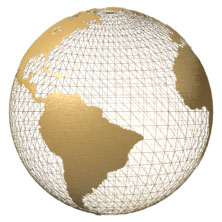| GigaPackets |
Toll Free Support: (888) 848-8749 |
|
Fixed Wireless Access

Managed SDN & SD-WAN
Dark Fiber - Wavelength Service
The Global Fiber Optic Nervous System
A worldwide network of fiber optic cables offers ever increasing bandwidths to interconnect global computing.The Earth is becoming one big brain. Electronic brain, that is. Every CPU is a cell in that brain and every data link is a nerve in the system. Gregory Stock described this phenomena in his book "Metaman" over a decade ago. If anything, the growing tentacles of long haul fiber optic cables are enabling this brain to grow bigger and faster every day.
In The News
Undersea fiber optic cables, also called submarine communications cables, are in the news lately. An earthquake off the coast of southern Taiwan damaged 8 undersea cables late in December of 2006. Some cables were severed in multiple places. This immediately slowed the data rates to Taiwan, South Korea, Japan, Hong Kong and mainland China, although other paths have kept some communications intact. How do you fix these cables? You have to grab them off the sea floor with grappling hooks and then splice them back together. It's a low tech approach to fixing a high tech system, but it works.What Makes a Fiber Optic Cable?
Fiber optic cable is, in principle, just a long string of glass. I suppose that's like saying microprocessor chips are also just highly processed sand. Optical fibers are very, very pure glass that is treated to create a very thin core surrounded by a cladding that has a different index of refraction. The combination of core and cladding traps laser light that is sent in one end of the fiber and guides it through up to 100 Km of cable to emerge at the other end with as little attenuation as possible. To create a transoceanic cable, solid state optical amplifiers called Erbium-doped amplifiers are inserted into the cable at intervals to boost the light signal.The Capacity and Value of Undersea Cable
Undersea fiberoptic cables have tremendous data carrying capacities even though they measure only about an inch in diameter. Some of the older cables may have bandwidths in the range of 200 to 600 Gbps. A new one in the works between the USA and China will have a capacity of 1.28 Tbps initially with expansion to 5.12 Tbps. That's Terabits per second, 1,000 Gbps per Tbps. How are these capacities practical? Individual fiber strands are so small that a cable may contain many strands. Each strand can transport multiple wavelengths of light using Wavelength Division Multiplexing. Each wavelength is a bit like having another independent fiber strand. The multiple wavelengths don't see each other as they co-exist in the fiber.From One Wire to a Web of Fiber
Undersea communications cables have been linking continents for about 150 years. The first one was laid by Cyrus Field in three attempts between 1858 and 1866 to establish a telegraph link between North America and Europe. Between that first transatlantic copper cable that was heralded as another wonder of the world and 1900, eight more were installed. Today there are about 1,000 undersea cables linking all the continents but Antarctica, with more in the works all the time. There are so many, that perfectly usable older cables have been decommissioned because their data rates are just too slow.Fiber Optic Lines Versus Satellite
There really is no substitute for this fiber optic nervous system. Data transfer rates have become so great that satellite communication can't handle it. Landlines, or should I say land and sea lines, have the additional advantage of lower latencies. A fiber optic path half-way around the world makes a signal travel only 24,902 miles for a round trip. That same trip via geosynchronous satellite is over 4x that. The difference is more significant between closer points on the Earth. A 1,000 mile link using a point to point fiber optic link is still 46,000 or so miles up and down to the satellite.Find Fiber Optic Bandwidth Services Now
Optical carrier services, including Fast Ethernet & Gigabit Ethernet over Fiber, SONET, Wavelengths, Dark Fiber and other high speed low latency digital line services, including Managed SDN Software Defined Networking and SD-WAN, for commercial business and organizational applications. Find out what network services and pricing are available now for your commercial business building anywhere in the U.S. Simply call 1-888-848-8749 or use this handy form...
Fiber Bandwidth & Cloud Services Inquiry
Thank you for your interest. A technology services expert will be in touch soon. Please provide accurate phone & email contact information or call toll free for support anytime at 1-888-848-8749. All information you provide will be used only to support your inquiry.

|